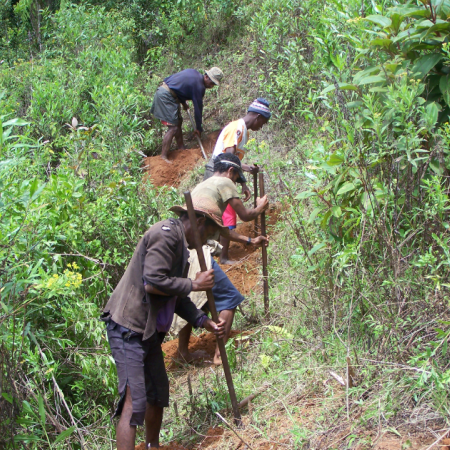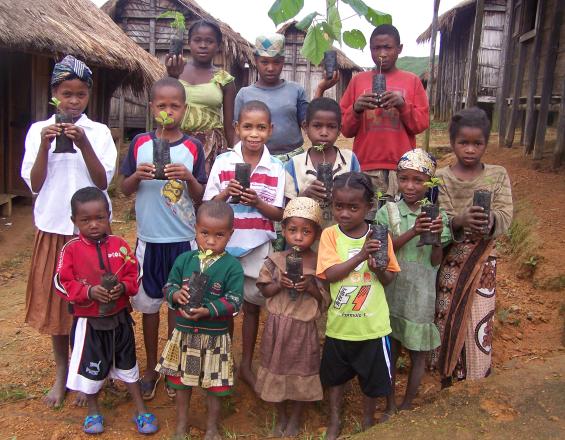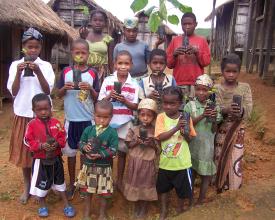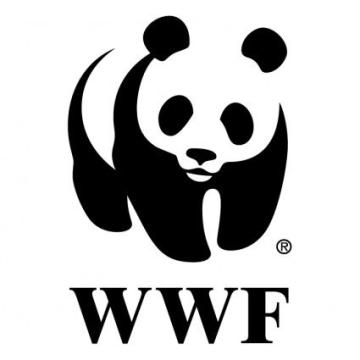
Restoration of Moist Tropical Forest (Fandriana-Marolambo Landscape in Madagascar)

WWF can look back on 13 years of lessons from this project. As a result of the project 95,063 ha were protected (Marolambo National Park), 51,743 ha are now managed by a community-based organisation and an area of 6,786 ha was placed under active or passive restoration. Working closely with communities, who previously were a key driver of deforestation and degradation in the area, has not only decreased pressures on the forest, but led to active involvement of the community in restoration activities. The project worked closely with the government at all levels. The programme specifically helped to establish 14 community-based organisations. 70 partner associations for agriculture were created and members trained in alternative agriculture techniques. 50 locally-run nurseries are now growing 100 native species and contribute to forest landscape restoration in the area. Local associations and people have fully taken over the FLR initiative since January 2018.
Context
Challenges addressed
A key challenge was that income by local communities in that landscape led to deforestation and degradation (shifting cultivation). The project had to build relationships and trust with the communities to slowly move them towards alternative income opportunities that reduced the pressure on the landscape. This required capacity building, technical support and sustainable financing mechanisms to ensure the sustainability of the introduced agriculture activities.
There was also a lack of awareness by local communities on the link between forests and climate change, as well as between restoration and water availability, erosion control and health.
There were unclear land status and tenure issues to resolve initially (including to obtain management rights for communities). There was further a lack of a common vision for the landscape, which was addressed in the project.
Location
Process
Summary of the process
There is a strong link between work with the communities and working with the government. The linkages are described in detail in building block 2.
Building Blocks
People are part of the solution- over the long term
The region in Madagascar we worked in was very complex with different needs of people in the landscape. As communities were key drivers of degradation and deforestation via slash and burn agriculture, we had to take a long term approach to build relationships and trust and to get community buy-in towards adopting alternative income opportunities and sustainable agriculture approaches. This included offering training, building capacity and awareness. In return we got them involved in restoration activities.
Communities have to take real ownership of the solution. The project gave the communities a joint vision and positive alternative to their previous way of living and working in the landscape. Achieving that buy in village by village takes time. The project area was large, with a Protected Area at the core, surrounded by many villages. Without a social component and cooperation, the chance for deforestation and degradation to continue is high.
For any project that deals with restoration and community engagement, giving it time is of big importance to ensure sustainability and long term effects.
Enabling factors
- It is important to understand the diversity of the people – the social dimension in the landscape
- Needs involvement of people with affinity to social issues – studies showing real alternatives raise credibility
- Social monitoring is important
- Build relationships – need to be present in the landscape to raise trust and build partnerships
- It requires time, both social aspects and forest restoration
- Build an exit strategy into your project design (or indicators to properly decide when exit is possible)
Lesson learned
- Forest landscape restoration has both an ecological and a social dimension, and the social one is fundamental to long term success.
- Take time to build relationship and be present in the landscape
- Ensure community takes real ownership
- Build capacity to support Forest Landscape Restoration
- Solid knowledge of the socio-cultural, political and ecological features of a landscape is important to better design and implement FLR interventions that are suited to local conditions.
- Integrate your activities within a landscape-scale plan.
- Restoring forested landscapes is a long-term process and much flexibility over the course of such an endeavour is needed. Periodic reappraisal is paramount.
Governance at all levels needs to buy in
In this project we worked closely with government at all levels.
National level: it was important to obtain political support on priorities and to agree on where restoration would be useful and where protected areas could established
Regional level: Regional buy in is very important - to convince regional government of the need for and positive consequences of establishing a protected area; key arguments were linked to social issues and income from the landscape – establishing a linkage between biodiversity protection and the development of income alternatives with the villages
Local level: Buy-in here focused on practical level decisions linked to resources for the villagers.
If not all levels agree then there is a danger for a “paper park”
That’s why it was important to bring all on board.
Enabling factors
There is need for building trust and relationships, particularly when working at regional and local government level. We did not have relationships with the villages before. The time invested and relationship building allowed us to engage people and develop activities. Positive signals from government were key here.
Lesson learned
- Strengthening local governance structures enables more stakeholders to take decisions which are necessary for the long-term success of FLR. It leads to real engagement of landscape stakeholders.
- For building relationships linked to governance we need to have people in strategic places to be able to engage with communities.
- National parks have limited resources – therefore it is important to create a win-win situation from this. Advantages for communities can lead to conservation benefits that also are supported by governance structures at all levels.
- Funding of such projects requires long term thinking
- Restoration outside a national park can work well and can happen at low cost with the help of the community
Impacts
Environmental benefits
Reduction of deforestation and degradation in the affected area. Working with the communities reduced the pressure on forests in the landscape significantly.
In the Western part of the landscape, the deforestation rates were very high before the project (>3% per year). During the period 2006 to 2016, this rate has been maintained below 1% and alternative incomes prevent communities from using a slash and burn approach, as they did previously.
Local communities are more aware of the link between forest restoration and water availability as well as erosion control and health. Communities are also actively participating in restoration activities.
95,063 ha were protected (Marolambo National Park), 51,743 ha are managed by a community-based organisation and an area of 6,786 ha was placed under active or passive restoration.
Social and economic benefits:
The communities income has been significantly diversified and now includes pig rearing, production of essential oils, fruit trees, beekeeping etc. As a result, food security has improved and incomes have increased.
70 partner associations for agriculture were established and members trained in seven alternative agriculture techniques. Around 1400 households benefitted either directly or indirectly from these alternative income generation schemes. Additional social benefits were secured through literacy courses
Beneficiaries
Established 14 community-based organisations (COBAs) and 70 partner associations for agriculture - their members were trained in alternative agriculture techniques.
Approximately 1400 households benefitted.
Sustainable Development Goals
Story

I remember 15 years ago, in March 2003, sitting in a workshop with my colleagues and our partners in Antananarivo for the first ever workshop in Madagascar on Forest Landscape Restoration (FLR). While Madagascar was no stranger to tree planting, FLR provided new insights for all of us in the room. It was a new approach for WWF, and the various programmes that WWF was launching around the globe were all in their early days.
Who was to know then that two years later we would embark on a 13-year FLR programme in the Fandriana-Marolambo landscape in Madagascar’s moist tropical forest, and that 12 years later, in 2015, our government would commit to restoring 4 million hectares of forest landscapes across the country. There was enthusiasm around the room, with public and private partners recognising the value of the FLR approach for a country like ours. The specific appeal of FLR for Madagascar is the fact that it not only focuses on restoring forest cover for ecological priorities, but also for human benefits.
Over the years, the project has evolved, built on previous phases and adapted responsively to local needs. It was a steep learning curve for all of us, we faced numerous challenges over time, but the experience we and our partners, acquired over this period is, we believe, worthy to share more widely. For this reason, I am very pleased that we are launching this field series of reports and very proud that Madagascar’s Fandriana-Marolambo landscape is the first in the series.
Nanie Ratsifandrihamanana, CEO of WWF Madagascar




